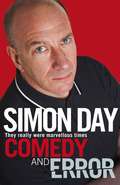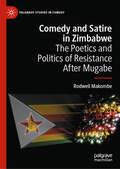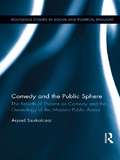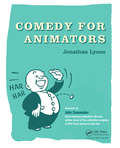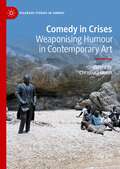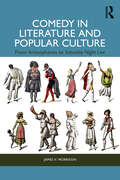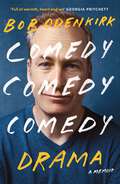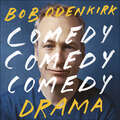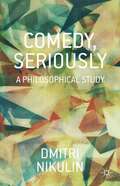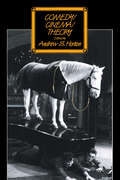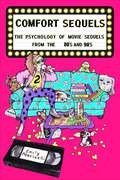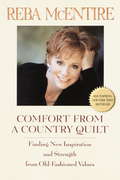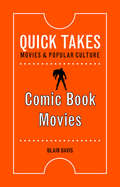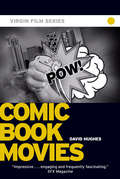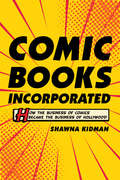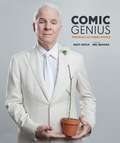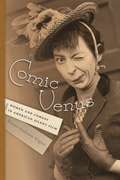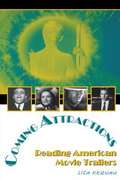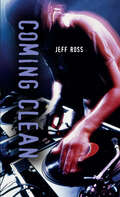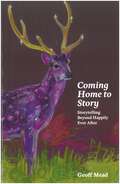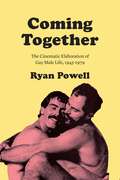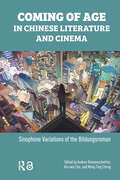- Table View
- List View
Comedy and Error: They Really Were Marvellous Times
by Simon DayBest known as one of the stars of the Fast Show (where he played characters such as Dave Angel -- Eco-Warrior, Tommy Cockles and Competitive Dad) and Bellamy's People co-starring Paul Whitehouse, Simon Day tells the shocking, sometimes sad and hilariously funny story of his life so far. Simon Day's memoir is a story of unlikely successes and secret lives. In the early 1980s he was a petty thief living rough in South East London and stealing whatever he could to fund an addiction to fruit machines. He was arrested and sentenced to borstal. Simon's memoir tells the story of how this nice, middle-class boy from the suburbs -- a self-confessed 'crap criminal' -- served time with the professionals and hard-cases in a jail fiercely divided along racial lines during the height of the 1981 riots. It moves on to the lucky breaks, the talent getting recognised, the 'redemption' of his years as a celebrity . . . with the parallel story of his addiction which -- with money and success -- became fuelled by drugs. Dark and dramatic, Simon Day's memoir is a laugh-out-loud-funny story of drugs, crime and comedy.
Comedy and Satire in Zimbabwe: The Poetics and Politics of Resistance After Mugabe (Palgrave Studies in Comedy)
by Rodwell MakombeThe book is about comedy, the nation, and resistance in Zimbabwe, following the fall of Robert Mugabe in 2017. It explores how satiric comedies and comic texts in post-Mugabe Zimbabwe contest hegemonic narratives of the nation and authorise alternative narratives from the margins. Drawing on postcolonial theories of the nation, it analyses subversive comedies and social media texts that contest official political narratives in Zimbabwe, including the comedies of four Zimbabwean comedians—Kapfupi and Marabha, Doc Vikela, and Sabhuku Vharazipi—as well as social media texts on President Mnangagwa&’s Facebook Page and cartoons published by the Zimbabwean newspaper ZimDaily. Primarily found via social media platforms (Facebook and Youtube), these texts centre alternative views and narratives of ordinary citizens, contesting established truths and providing a counter-narration to official hegemonic discourses of the nation. Where existing scholarship on post-Mugabe politics in Zimbabwe focuses on issues such as the coup, militarisation, and discourses of "newness", little attention has been paid to the forms of resistance used in everyday discourse by Zimbabweans, and particularly via satire and comedy. These comic texts, shared by comedians and normal citizens on social media, can provide a useful alternative perspective to make sense of the politics and political performances that characterize the new political dispensation after Mugabe.
Comedy and the Public Sphere: The Rebirth of Theatre as Comedy and the Genealogy of the Modern Public Arena (Routledge Studies in Social and Political Thought #77)
by Arpad SzakolczaiThe book aims at reframing the discussion on the "public sphere," usually understood as the place where the public opinion is formed, through rational discussion. The aim of this book is to give an account of this rationality, and its serious shortcomings, examining the role of the media and the confusing of public roles and personal identity. It focuses in particular on the role of the theatrical and comical in the historical development of the public sphere, and in this manner reformulating definitions of common sense, personal identity, and culture.
Comedy for Animators
by Jonathan LyonsWhile comedy writers are responsible for creating clever scripts, comedic animators have a much more complicated problem to solve: What makes a physical character funny? Comedy for Animators breaks down the answer by exploring the techniques of those who have used their bodies to make others laugh. Drawing from traditions such as commedia dell'arte, pantomime, Vaudeville, the circus, and silent and modern film, animators will learn not only to create funny characters, but also how to execute gags, create a comic climate, and use environment as a character. Whether you're creating a comic villain or a bumbling sidekick, this is the one and only guide you need to get your audience laughing! Explanation of comedic archetypes and devices will both inspire and inform your creative choices Exploration of various modes of storytelling allows you to give the right context for your story and characters Tips for creating worlds, scenarios, and casts for your characters to flourish in Companion website includes example videos and further resources to expand your skillset--check it out at www.comedyforanimators.com! Jonathan Lyons delivers simple, fun, illustrated lessons that teach readers to apply the principles of history's greatest physical comedians to their animated characters. This isn't stand-up comedy--it's the falling down and jumping around sort!
Comedy in Crises: Weaponising Humour in Contemporary Art (Palgrave Studies in Comedy)
by Chrisoula LionisComedy in Crises provides a novel contribution to an emerging comedy studies field, offering a fresh approach and understanding toward both the motivation and reception of humour in diverse contemporary art contexts. Drawing together research by artists, theorists, curators, and historians from around the world (from Palestine, to Greece, Brazil, and Indigenous Australia), it provides new insight into how humour is weaponised in contemporary art – focusing on its role in negotiating complex cultural identities, the expectations of art markets, the impact of historical legacies, as well as its role in bolstering cultural resilience. In so doing, this book explores a vital, yet under-explored, aspect of contemporary art. Over the last decade, we have witnessed an overwhelming emphasis on experiences of precarity and emergency in contemporary art discourse, reflecting a popular view that the decade following the outbreak of the global financial crisis has been marked by an intersection of constant crises (refugee crisis, sovereign debt crisis, environmental disaster, COVID). Comedy in Crises offers innovative analysis of the relationship between this context and the growing use of humour by artists from around the world, making clear the vital role of laughter in mediating the collective trauma that takes shape today in a period of protracted crisis.
Comedy in Literature and Popular Culture: From Aristophanes to Saturday Night Live
by James V. MorrisonComedy in Literature and Popular Culture: From Aristophanes to Saturday Night Live explores works of comedy from the past 2,500 years.James V. Morrison discusses works including those of Aristophanes and Plautus, Shakespeare and Moliere, and modern comic writers, performers, and cartoonists, such as Thomas Nast, P. G. Wodehouse, Charlie Chaplin, and Jerry Seinfeld, asking the following questions: Is comedy a mirror of our lives? Is it “funny ’cuz it’s true?” Or is it funny because it ignores reality? Should we distinguish between the plot of a comic play and the jokes found in it? Are the jokes just there to make us laugh or are the jokes as essential as the plot? Do memories of satirical portrayals on the comic stage displace recollections of the historical person? By juxtaposing works from different cultures and time periods, the book demonstrates a universal recourse to certain familiar techniques, situations, and characters.This vibrant study offers a compelling analysis of comedy as a mode, form, and genre. It is an engaging read for students and scholars of comparative literature, literary history, media studies, and theater and performance.
Comedy, Comedy, Comedy, Drama: A Memoir
by Bob OdenkirkIn this hilarious, heartfelt memoir, the star of Mr. Show and Breaking Bad spin off Better Call Saul opens up about the highs and lows of showbiz, his cult status as a comedy writer, and what it's like to reinvent himself at age fifty as an action-film ass-kicker.Bob Odenkirk's career is inexplicable. And yet he will try like hell to explicate it for you. Charting a "Homeric" decades-long "odyssey" from his origins in the seedy comedy clubs of Chicago to a dramatic career full of award nominations-with a side-trip into the action-man world that is baffling to all who know him-it's almost like there are many Bob Odenkirks! But there is just one, and one is plenty.Bob embraced a life in comedy after a chance meeting with Second City's legendary Del Close, then somehow made his way to a job as a writer at Saturday Night Live. While surviving that legendary gauntlet by the skin of his gnashing teeth, he stashed away the secrets of comedy writing-eventually employing them in the immortal "Motivational Speaker" sketch for Chris Farley, honing them on The Ben Stiller Show, and perfecting them on Mr. Show with Bob and David.In Hollywood, Bob demonstrated a bullheadedness that would shame Sisyphus himself, and when all hope was lost for the umpteenth time, the phone rang with an offer to appear on Breaking Bad-a show about how boring it is to be a high school chemistry teacher. His embrace of this strange new world of dramatic acting led him to working with Steven Spielberg, Alexander Payne, and Greta Gerwig, and then, in a twist that will confound you, he re-re-invented himself as a bona fide action star. Why? Read this and do your own psychoanalysis-it's fun!Featuring humorous tangents, never-before-seen photos, wild characters, and Bob's trademark unflinching drive and humour, Comedy Comedy Comedy Drama is a classic showbiz tale told by a determined idiot.
Comedy, Comedy, Comedy, Drama: The Sunday Times bestseller
by Bob OdenkirkIn this brilliantly entertaining and heartfelt memoir, beloved star and comic maverick Bob Odenkirk writes honestly about the highs and lows of showbiz: his work on infamous cult comedy Mr. Show, as a performer and writer on legendary series such as The Larry Sanders Show and Saturday Night Live, becoming everyone's favourite lawyer in global hit TV series' Breaking Bad and Better Call Saul, and what it's like to reinvent himself as an action film ass-kicker at fifty in Nobody. Bob Odenkirk's career is inexplicable. And yet he will try like hell to explicate it for you... Featuring humorous tangents, never-before-seen photos, wild characters, and Bob's trademark unflinching drive and humour, Comedy Comedy Comedy Drama is a classic showbiz tale told by a determined idiot.(P) 2022 Penguin Audio
Comedy, Seriously
by Dmitri NikulinComedy, Seriously provides a philosophical interpretation of comedy and argues that comedy displays a particular kind of rationality that reflects philosophical thinking. In particular, that comedy is defined not so much by laughter or jokes, but rather the structure of its plot, which is isomorphic with that of the philosophical argument. Comedy allows for the resolution of a conflict and the achievement of well-being and equality through action that follows the comic plot. Moreover, such action is propelled by the 'thinker on stage, ' who, as socially and politically oppressed, contributes to the liberation of all and the achievement of the good life. Comedy, therefore, establishes the universal pattern for justice and well-being and allows us to rethink the notion of subjectivity not as the modern isolated subject, but rather as integrated with others through shared action and dialogical involvement.
Comedy/Cinema/Theory
by Andrew HortonThe nature of comedy has interested many thinkers, from Plato to Freud, but film comedy has not received much theoretical attention in recent years. The essays in Comedy/Cinema/Theory use a range of critical and theoretical approaches to explore this curious and fascinating subject. The result is a stimulating, informative book for anyone interested in film, humor, and the art of bringing the two together.Comedy remains a central human preoccupation, despite the vagaries in form that it has assumed over the centuries in different media. In his introduction, Horton surveys the history of the study of comedy, from Aristophanes to the present, and he also offers a perspective on other related comic forms: printed fiction, comic books, TV sitcoms, jokes and gags.Some essays in the collection focus on general issues concerning comedy and cinema. In lively (and often humorous) prose, such scholars as Lucy Fischer, Noel Carroll, Peter Lehman, and Brian Henderson employ feminist, post-Freudian, neo-Marxist, and Bakhtinian methodologies. The remaining essays bring theoretical considerations to bear on specific works and comic filmmakers. Peter Brunette, William Paul, Scott Bukatman, Dana Polan, Charles Eidsvik, Ruth Perlmutter, Stephen Mamber, and Andrew Horton provide different perspectives for analyzing The Three Stooges, Chaplin, Jerry Lewis, Woody Allen, Dusan Makavejev, and Alfred Hitchcock's sole comedy, Mr. and Mrs. Smith, as well as the peculiar genre of cynical humor from Eastern Europe.As editor Horton notes, an over-arching theory of film comedy does not emanate from these essays. Yet the diversity and originality of the contributions reflect vital and growing interest in the subject, and both students of film and general moviegoers will relish the results.
Comfort Sequels: The Psychology of Movie Sequels from the 80s and 90s
by Emily MarinelliThis sneaky memoir celebrates the campiness and nostalgia of some of the more infamous (some might say underappreciated) sequels of the eighties and nineties, with brand-new interviews with cast and creative team members, while at the same time emphatically conveying the restorative power these films had on the author's traumatic -- sometimes even dangerous -- upbringing. In the late eighties and early nineties, while other kids were playing softball, Emily was sporting a Pink Ladies jacket, perfecting Michelle Pfeiffer&’s &“Cool Rider&” choreography from Grease 2, and wearing out the VHS player. Comfort Sequels: The Psychology of Movie Sequels from the 80s and 90s tells stories from Emily's life, through the movie sequels of their childhood. When a film touches us, makes us deep-belly laugh, and has that feel-good spirit, we want more of it. We want the continuing story. We want the same story even, just recycled and offered in a slightly new way. What felt so good about the original can come back twofold and be the same, but different. Comfort Sequels examines the psychology behind what makes certain movie sequels memorable, safe, predictable, and comforting. These sequels are more of the universe we love—exploring something new while maintaining that which is familiar. Comfort Sequels is a sneaky memoir, celebrating the campiness and nostalgia that these films evoke. Every chapter is a love letter to a specific movie sequel. As a licensed psychotherapist and psychology professor, Emily interprets characters, story arcs, and major themes in a unique voice from a unique perspective while sharing fun and random behind-the-scenes facts about each film. Featuring interviews with Muppeteer Steve Whitmire (creator of Rizzo the Rat from The Great Muppet Caper), Christine Ebersole (My Girl 2), Stuart Pankin (Mannequin 2: On the Move), Peter Mosen (Ghostbusters II), Christopher McDonald and Leif Green (Grease 2), and the &“Cool Rider&” himself, Maxwell Caulfield (Michael, also from Grease 2). Comfort Sequels covers the following twelve comfort sequels; Grease 2, My Girl 2, Karate Kid: Part II, The Great Muppet Caper, Teenage Mutant Ninja Turtles 2: The Secret of the Ooze, Ghostbusters II, Batman Returns, Dream a Little Dream 2, Mannequin 2: On the Move, The Neverending Story II: The Next Chapter, and The Evening Star.
Comfort and Domestic Space in Modern Spain (Toronto Iberic #91)
by Susan LarsonComfort and domestic space are complex narratives that can help draw our attention to everything from urban planning, everyday objects, and new technologies to class conflict, racial and ethnic segregation, and the gendering of domestic labour. Comfort and Domestic Space in Modern Spain delves into the history of ideas surrounding the modern home. It explores how the collective experience of domestic space has been shaped by government ideologues, technocrats, and artists as well as working- and middle-class Spaniards since the late nineteenth century. The book focuses on the social and cultural meanings of domestic space in ways that invite us to cross boundaries between private and public, the particular and the general, the local and the global, and to pay attention to the role of the cultural imagination in making a house into a home. Considering a wide variety of voices and perspectives that have resulted in new ideas about how to inhabit domestic space, Comfort and Domestic Space in Modern Spain brings together an international, interdisciplinary group of scholars to illuminate the cultural history of everyday life.
Comfort from a Country Quilt
by Reba McentireThe New York Times Bestseller That Reads Like a Back-Porch Conversation with Reba!In a dazzling career, Reba McEntire has become a true country superstar--and a trailblazing businesswoman with her own multimedia entertainment corporation. Yet she is a rare celebrity who is also beloved by her millions of fans for the way she lives her life. For Reba has balanced the demands of career and family, succeeded in show business without sacrificing her values, and kept up with the times without abandoning her country roots.Here Reba writes about the roles a modern woman tries to fill, roles as many and varied as the fabric pieces of an heirloom quilt. Facing the challenges of being a wife, mother, stepmother, daughter, sister, performer, executive, community member, and Christian, Reba has found inspiration and comfort in the values of her past as an Oklahoma ranch girl. In this generous and wise book, she shows how you can keep traditional values fresh and vital in your own search for a fulfilling life.Whether you read it for instant warmth or lasting inspiration, Comfort from a Country Quilt is a book that will make your spirits soar like the sweet high notes of a Reba McEntire song.
Comic Acting and Portraiture in Late-Georgian and Regency England
by Jim DavisThe popularity of the comic performers of late-Georgian and Regency England and their frequent depiction in portraits, caricatures and prints is beyond dispute, yet until now little has been written on the subject. In this unique study Jim Davis considers the representation of English low comic actors, such as Joseph Munden, John Liston, Charles Mathews and John Emery, in the visual arts of the period, the ways in which such representations became part of the visual culture of their time, and the impact of visual representation and art theory on prose descriptions of comic actors. Davis reveals how many of the actors discussed also exhibited or collected paintings and used painterly techniques to evoke the world around them. Drawing particularly on the influence of Hogarth and Wilkie, he goes on to examine portraiture as critique and what the actors themselves represented in terms of notions of national and regional identity.
Comic Book Movies (Quick Takes: Movies and Popular Culture)
by Blair DavisComic Book Movies explores how this genre serves as a source for modern-day myths, sometimes even incorporating ancient mythic figures like Thor and Wonder Woman’s Amazons, while engaging with the questions that haunt a post-9/11 world: How do we define heroism and morality today? How far are we willing to go when fighting terror? How can we resist a dystopian state? Film scholar Blair Davis also considers how the genre’s visual style is equally important as its weighty themes, and he details how advances in digital effects have allowed filmmakers to incorporate elements of comic book art in innovative ways. As he reveals, comic book movies have inspired just as many innovations to Hollywood’s business model, with film franchises and transmedia storytelling helping to ensure that the genre will continue its reign over popular culture for years to come.
Comic Book Movies - Virgin Film
by David HughesThe superheroes are back! Since the 1970s, the film world has found inspiration in comic books and graphic novels. These days no summer is complete without a major blockbuster movie based on a comic: Superman, Batman, Spider-Man, X-Men, Men in Black, Daredevil, and The Hulk. Modern special effects have made large-scale superhero epics possible, but the diversity of the comics being published has made for a wide variety of subjects, as evidenced by Ghost World, From Hell, Akira and Road to Perdition. This book looks in detail at twenty key titles, covering every step of the development from comic book panel to feature film frame. Includes interviews with key creative artists about the evolution of the films from the original comics, and speculates about future films.
Comic Books Incorporated: How the Business of Comics Became the Business of Hollywood
by Shawna KidmanComic Books Incorporated tells the story of the US comic book business, reframing the history of the medium through an industrial and transmedial lens. Comic books wielded their influence from the margins and in-between spaces of the entertainment business for half a century before moving to the center of mainstream film and television production. This extraordinary history begins at the medium’s origin in the 1930s, when comics were a reviled, disorganized, and lowbrow mass medium, and surveys critical moments along the way—market crashes, corporate takeovers, upheavals in distribution, and financial transformations. Shawna Kidman concludes this revisionist history in the early 2000s, when Hollywood had fully incorporated comic book properties and strategies into its business models and transformed the medium into the heavily exploited, exceedingly corporate, and yet highly esteemed niche art form we know so well today.
Comic Genius
by Mel Brooks Matt HoyleThis star-studded tribute to the kings and queens of comedy draws together such legendary names as Steve Martin, Tina Fey, Steve Carell, Eddie Murphy, Robin Williams, Ricky Gervais, and many more. Granted extraordinary access, photographer Matt Hoyle has captured his subjects in portraits that are works of art in themselves--by turns zany and deadpan, laugh-out-loud and contemplative. Accompanying them are first-person reflections from each of the comedians on life and laughter that always cut straight to the heart of comedy: it's funny because it's true. Page after sidesplitting page in Comic Genius offers prose as engaging as each portrait is memorable. Here, in one handsome package, is the gift of laughter itself. Comic Genius is proud to support Save The Children.
Comic Venus: Women And Comedy In American Silent Film (Contemporary Approaches To Film And Media Ser.)
by Kristen Anderson WagnerFor many people the term “silent comedy” conjures up images of Charlie Chaplin’s Little Tramp, Buster Keaton’s Stoneface, or Harold Lloyd hanging precariously from the side of a skyscraper. Even people who have never seen a silent film can recognize these comedians at a glance. But what about the female comedians? Gale Henry, Louise Fazenda, Colleen Moore, Constance Talmadge—these and numerous others were wildly popular during the silent film era, appearing in countless motion pictures and earning top salaries, and yet, their names have been almost entirely forgotten. As a consequence, recovering their history is all the more compelling given that they laid the foundation for generations of funny women, from Lucille Ball to Carol Burnett to Tina Fey. These women constitute an essential and neglected sector of film history, reflecting a turning point in women’s social and political history. Their talent and brave spirit continues to be felt today, and Comic Venus: Women and Comedy in American Silent Film seeks to provide a better understanding of women’s experiences in the early twentieth century, and to better understand and appreciate the unruly and boundary-breaking women who have followed. The diversity and breadth of archival materials explored in Comic Venus illuminate the social and historical period of comediennes and silent film. In four sections, Kristen Anderson Wagner enumerates the relationship between women and comedy, beginning with the question of why historically women weren’t seen as funny or couldn’t possibly be funny in the public and male eye, a question that persists even today. Wagner delves into the idea of women’s “delicate sensibilities,” which presumably prevented them from being funny, and in chapter two traces ideas about feminine beauty and what a woman should express versus what these comedic women did express, as Wagner notes, “comediennes challenged the assumption that beauty was a fundamental component of ideal femininity.” In chapter three, Wagner discusses how comediennes such as Clara Bow, Marie Dressler, and Colleen Moore used humor to gain recognition and power through performances of sexuality and desire. Women comedians presented “sexuality as fun and playful, suggesting that personal relationships could be fluid rather than stable.” Chapter four examines silent comediennes’ relationships to the modern world and argues that these women exemplified modernity and new womanhood. The final chapter of Comic Venus brings readers to understand comediennes and their impact on silent-era cinema, as well as their lasting influence on later generations of funny women. Comic Venus is the first book to explore the overlooked contributions made by comediennes in American silent film. Those with a taste for film and representations of femininity in comedy will be fascinated by the analytical connections and thoroughly researched histories of these women and their groundbreaking movements in comedy and stage.
Coming Attractions: Reading American Movie Trailers
by Lisa KernanStarting from the premise that movie trailers can be considered a film genre, this pioneering book explores the genre's conventions and offers a primer for reading the rhetoric of movie trailers. Lisa Kernan identifies three principal rhetorical strategies that structure trailers: appeals to audience interest in film genres, stories, and/or stars. She also analyzes the trailers for twenty-seven popular Hollywood films from the classical, transitional, and contemporary eras, exploring what the rhetorical appeals within these trailers reveal about Hollywood's changing conceptions of the moviegoing audience. Kernan argues that movie trailers constitute a long-standing hybrid of advertising and cinema and, as such, are precursors to today's heavily commercialized cultural forms in which art and marketing become increasingly indistinguishable.
Coming Clean (Orca Soundings)
by Jeff RossThis could be Rob's big break or the night everything falls apart. Rob wants to be a DJ—more than anything. And when his older brother Adam lands him a gig at a local all-ages club filling in for DJ Sly, Rob is ecstatic. When he finds out that the girl of his dreams will be there that first night, it seems like it is all coming together. But things fall apart—Mary Jane overdoses on Ecstasy provided by Adam, and DJ Sly turns Adam in and implicates Rob. The brothers end up on the run, evading the police while trying to force DJ Sly to tell the truth about the brothers' part in the death and Sly's own role in supplying drugs at the club. This short novel is a high-interest, low-reading level book for teen readers who are building reading skills, want a quick read or say they don’t like to read!
Coming Home to Myself
by Wynonna JuddThe no-holds-barred memoir from the beloved music superstar. From the heart of one of the most beloved performers in music comes a candid memoir of professional triumph, private heartbreak, and personal victory-a coming-of-age account of a very private search for harmony and a very public rise to fame. Coming Home to Myselfis the result of that emotional journey-a song of personal discovery that taught Wynonna Judd to love not just what she does, but who she is. From a truly exceptional woman comes an unexpected memoir of survival, strength, hope, and forgiveness, filled with an exultant and empowering message certain to resonate with those who have dreamed of finding themselves, and who only needed the courage and inspiration to begin their own journey.
Coming Home to Story: Storytelling Beyond Happily Ever After
by Geoff MeadStories take us into other worlds so that we may experience our own more deeply. Master storyteller Geoff Mead brings the reader inside the experience of telling and listening to a story. He shows how stories and storytelling engage our imaginations, strengthen communities and bring adventure and joy into our lives. The narrative is interspersed with consummate retellings of traditional tales from all over the world.
Coming Together: The Cinematic Elaboration of Gay Male Life, 1945-1979
by Ryan PowellIn Coming Together, Ryan Powell captures the social and political vitality of the first wave of movies made by, for, and about male-desiring men in the United States between World War II and the 1980s. From the underground films of Kenneth Anger and the Gay Girls Riding Club to the gay liberation-era hardcore films and domestic dramas of Joe Gage and James Bidgood, Powell illuminates how central filmmaking and exhibition were to gay socializing and worldmaking. Unearthing scores of films and a trove of film-related ephemera, Coming Together persuasively unsettles popular histories that center Stonewall as a ground zero for gay liberation and visibility. Powell asks how this generation of movie-making—which defiantly challenged legal and cultural norms around sexuality and gender—provided, and may still provide, meaningful models for living.
Coming of Age in Chinese Literature and Cinema: Sinophone Variations of the Bildungsroman
by Kiu-Wai Chu Andrea Riemenschnitter Mung Ting ChungWith the inclusion of twelve original articles by established and emerging international scholars, this volume offers critical reading of literary and cinematic texts produced in China and Sinophone communities between the 1950s and 2010s. The articles portray the lineage and mutations of the Chinese Bildungsroman, providing insights into the tensions between individual and society; nation and the world; and the multiple social, ecological, and virtual realities of recent decades. Concerned with how coming-of-age narratives have persistently returned and evolved over time, the book addresses themes such as family and social change; gender, class, and generational divides, local/global politics, and the ecological and posthuman turns in Chinese/Sinophone culture. It offers a fresh look on how the transnational and transgenerational journeys of Bildungsroman and coming-of-age narratives continuously transform and reinvigorate generic conventions, to explore adolescence as a formative social force and aesthetic experience in Chinese/Sinophone literature and film.This book aims to open up dialogues for better understanding emergent cultural forms that reflect social instability arising from the global spread of contemporary neo-liberal capitalism, and to constitute the foundation of an innovative history of Sinophone literature. It does not only take into account the complicated survival struggles of the subjects of Mao's revolution including refugee-immigrants turned colonial subjects, but also the interaction between literature and the arts as well as between human and nonhuman agents (place, material culture, nature, etc.).
